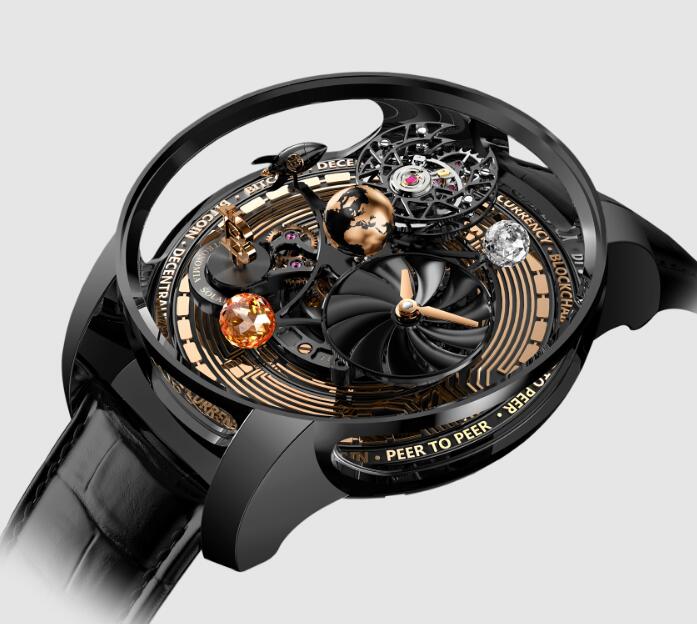
Lots of mechanical fireworks and snapshots of the night sky.
The Astronomia series tourbillon is Jacob & Co’s unique way of creating astronomical complications. In general, they are not intended to represent the actual astronomical cycle with a high degree of accuracy (currently the most complicated example of a watch is probably Vacheron Constantin’s Celestia). Instead, they are a kinetic sculpture of the wrist, based on a four-armed carrier system that supports various additional displays or representations of celestial bodies.
Astronomia watches also feature a very thick case and high domed crystals, emphasizing the three-dimensionality of the carrier structure (as well as providing a true celestial vision). While we’ve said that in general, accurate celestial cycles are not what Jacob & Co. seeks in these watches, in the case of the Astronomia Sky there is a very precise sidereal time indication, as well as an elevated indication of the stars .
The entire carrier system rotates around the dial every 20 minutes. At the end of each arm is a dial showing the time, moving clockwise; a stylized rocket ship running stopwatch that rotates on its own axis once every minute; a dual-axis tourbillon (plus the central rotation point of the carrying system) , actually a three-axis tourbillon) and a rotating globe cut from orange sapphire.
The dial showing the time is fixed to the differential, so no matter where it is mounted, it is always facing up. Just behind it, you can see the central globe, which rotates within a tinted sapphire hemisphere (the globe is hand-carved titanium and turns every 24 hours).
The tourbillon rotates around its innermost axis every 60 seconds and around its outer axis every 5 minutes (3 times per hour, of course, around the inside of the watch).
The original planetarium had a spherical diamond, and here, in the sky, you can see an orange sapphire. The idea of a diamond is that it is a stylized representation of the moon. Orange sapphire doesn’t have this similarity, but you can, since its rotation period isn’t meant to simulate any particular celestial body, so you can pretend it’s an orange planet or star of your choice (I’d go to Mars myself….. .. it seems to work with the rocket ship on the opposite carrier). This gemstone has 288 facets, and the cut developed for the gemstone used in the planetarium is actually patented. Since the central carrier rotates every 20 minutes, the watch looks different every time you watch it, and if it’s on your wrist, you’ll probably be looking at it a lot.
Creating an astronomical tourbillon requires not only design imagination, but also research to solve some very difficult technical problems. copy watches for sale
Now, we did mention astronomical watches, in general, aren’t astronomically accurate celestial cycles? However, the astronomical sky does contain sidereal time complications. You can find it in a dark blue titanium dial with constellations and stars in 18k yellow gold. Once every sidereal day, an oval representing the horizon orbits the dial, and the stars and constellations that appear in it are those currently visible overhead.
The transparent sides of the case allow you to see the month indication on the side of the dial—the dial actually rotates as well, making a full revolution every sidereal year.
Given its size and complexity, you might think the Astronomia Sky is a heavy watch. It’s certainly not lightweight (in any sense), but it’s more wear-resistant than you might think, in part because much of the watch’s body is made of fairly lightweight materials (such as titanium and sapphire). luxury copy watches
This kind of minimalist watchmaking is the kind of thing people have tried a lot in the past, say, a decade or so, but it takes a lot of sheer energy to make it work, and you have to have something that a lot of people think they have The things that truly transcend peak talent, but that’s not the case. It would help if there were some real technical points of interest behind the watch as well, and getting all these relatively bulky components to work together on a carrier system is a lot harder than you might imagine from the visually spectacular end result. As a pure show, there’s very little that comes close to the astronomical sky, and I found this particular model – with sidereal day, year, and star map indications – to be the most compelling version to date.
Astronomical Sky: Designed by Jacob Arabo in collaboration with Studio 7h38. Movement, unique (obviously) hand-wound movement JCAM11; 40mm x 17.15mm, titanium main plate. Frequency, 21,600 vph, 42 jewels, three-axis tourbillon. Power reserve, 60 hours. Sidereal day and year display with month of year indication; night sky indication. The lacquered hand-carved titanium globe rotates every 24 hours. “Jacob Cut” orange sapphire, 1 carat, 228 facets. Case, 47mm x 25mm, rose gold, sapphire window; domed sapphire crystal with anti-reflective coating. Waterproof, 30 meters. Jacob & Co. ASTRONOMIA SOLAR BITCOIN AS310.21.AB.AA.A